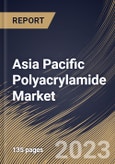Polyacrylamide is utilized in mining operations as a flocculant to separate mineral solids from water in the mineral processing stages. This application aids in the recovery of valuable minerals and the efficient disposal of waste. The textile industry employs polyacrylamide as a sizing agent to improve the binding of fibers while manufacturing textiles. It also helps in reducing the consumption of dyes and chemicals.
Stringent environmental regulations and the need for sustainable water management practices have boosted the demand for polyacrylamide, particularly in the water treatment sector. Governments and industries are increasingly focusing on minimizing the environmental impact of their operations. As agriculture strives for higher productivity and sustainability, adopting polyacrylamide-based soil conditioners and erosion control measures has increased. Farmers are looking for solutions that optimize water use and minimize soil degradation.
Some foreign paper manufacturers have invested in India to tap into the growing market. Joint ventures and partnerships with Indian companies have led to the establishment of modern paper mills. Sustainability has become a key focus in the paper industry. Many Indian paper mills have increased their use of recycled paper as a raw material and have implemented eco-friendly practices to reduce their environmental impact. The Indian paper industry has been exploring export opportunities in neighboring countries and global markets. Competitive pricing and quality have made Indian paper products attractive in international markets. In the paper making industry, the application of polyacrylamide is carefully controlled to optimize paper quality and production efficiency while minimizing environmental impact. These factors will enhance the demand for polyacrylamides in the Asia Pacific region.
The China market dominated the Asia Pacific Polyacrylamide Market, by Country in 2022, and would continue to be a dominant market till 2030; thereby, achieving a market value of $1,358.2 Million by 2030. The Japan market is registering a CAGR of 6% during (2023 - 2030). Additionally, The India market would showcase a CAGR of 7.4% during (2023 - 2030).
Based on Product, the market is segmented into Anionic, Cationic, and Non-ionic. Based on Application, the market is segmented into Water Treatment, Oil & Gas, Paper Making, and Others. Based on countries, the market is segmented into China, Japan, India, South Korea, Australia, Malaysia, and Rest of Asia Pacific.
The market research report covers the analysis of key stake holders of the market. Key companies profiled in the report include Anhui Jucheng Fine Chemicals Co., LTD, Ashland, Inc., BASF SE, Kemira Oyj, SNF Group, Black Rose Industries Ltd., Shandong Baomo Biochemical Co., Ltd., Xitao Polymer Co., Ltd., The Dow Chemical Company (Dow Corning Ltd.), and Solvay SA.
Scope of the Study
Market Segments Covered in the Report:
By Product (Volume, Kilo Tonnes, USD Million, 2019-2030)- Anionic
- Cationic
- Non-ionic
- Water Treatment
- Oil & Gas
- Paper Making
- Others
- China
- Japan
- India
- South Korea
- Australia
- Malaysia
- Rest of Asia Pacific
Key Market Players
List of Companies Profiled in the Report:
- Anhui Jucheng Fine Chemicals Co., LTD
- Ashland, Inc.
- BASF SE
- Kemira Oyj
- SNF Group
- Black Rose Industries Ltd.
- Shandong Baomo Biochemical Co., Ltd.
- Xitao Polymer Co., Ltd.
- The Dow Chemical Company (Dow Corning Ltd.)
- Solvay SA
Unique Offerings
- Exhaustive coverage
- The highest number of Market tables and figures
- Subscription-based model available
- Guaranteed best price
- Assured post sales research support with 10% customization free
Table of Contents
Companies Mentioned
- Anhui Jucheng Fine Chemicals Co., LTD
- Ashland, Inc.
- BASF SE
- Kemira Oyj
- SNF Group
- Black Rose Industries Ltd.
- Shandong Baomo Biochemical Co., Ltd.
- Xitao Polymer Co., Ltd.
- The Dow Chemical Company (Dow Corning Ltd.)
- Solvay SA
Methodology

LOADING...








